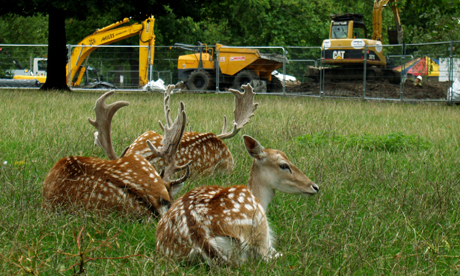Clissold deer death raises welfare concerns

Is Clissold Park suitable for its resident deer? Photo: © Izzie Tran
On Thursday 12 August intruders broke into the deer enclosure in Clissold Park, causing a deer to break its leg. The animal was put down the next day by an RSPCA inspector.
So, the vandals broke in, a deer was injured, Hackney Council had to put it down. Bad vandals, good council, very sad, end of story.
Well, no, actually. In Hackney there’s no expertise in handling deer. The local vet isn’t a deer specialist (only a handful of vets are); the staff aren’t trained by experts. And the perimeter fencing had been left insecure.
The recent events seem to be a symptom of a too-casual approach to animal welfare. Experts say that evacuating the deer during the park refurbishments would have caused them great distress.
Agreed, but what efforts were made to reduce the stress of living in a building site? Over the past weeks, the deer have been hemmed in by heavy machinery cutting, shredding, excavating, demolishing, building, earth-moving: a cacaphony audible half a mile away.
Work has continued even inside the deer enclosure, and temporary fence panels, changing the shape of their habitat by the day, have reduced their living area by a third.
The undergrowth that used to screen these shy animals from the cafe has been torn away. Inside a few weeks, their habitat has changed beyond recognition.
Even before the renovations, their paddock was in a sorry state. The lack of shelter and the feast of junk food fed by unsupervised visitors breach the government code on farmed deer that it urges park owners to follow. And what happens at night when the vandals come to play? An eminent deer specialist who attended the zoo some years ago is of the opinion that while fallow deer can thrive in city parks, Clissold Park is not a suitable place for them.
But the new enclosure will be worth the trouble, you protest. No, it won’t. The only slightly larger paddock will be exposed on all sides – opened up to the mansion and a new footpath for “better viewing”.
No refuge or ground-cover here for these “highly strung, nervous animals” as the Department for Environment, Food and Rural Affairs (DEFRA) describes them. This is the deer Camp X-Ray!
This year’s Park Management Plan complains that the zoo’s outhouses spoil the view from the mansion. Will the new design exclude the shelter advised by DEFRA?
As a small local authority zoo exempt from a zoo licence, Clissold Park polices itself.
What a contrast to Alexandra Palace Park in neighbouring borough Haringey, which has around 15 deer compared to our 11. They are split into two groups in separate compounds, swapped around twice a year for a change of scene. There is undergrowth and dead-bush cover for the deer to retreat into. A well-known specialist deer vet inspects annually. Working closely with him is an expert deer husbandry manager who visits four times a year and inducts staff, and can be called out in emergencies.The same animals have been there over 20 years. They don’t have a vandals problem.
The good news is that the Council has called in Ally Pally’s expert vet, who also works for the Royal Parks and the National Trust, to assess the health and welfare of the Clissold herd. Finally.
Here’s a plan. If the expert vet concurs with earlier professional opinion that the deer enclosure is unsuitable, then close it down. But if the compound is considered viable, take the following action:
Like Alexandra Park, contract a specialist vet for annual inspections, with quarterly visits from a deer manager who can train staff and attend in a crisis.
Have a deer expert redesign the new enclosure with animal welfare the paramount concern and start planting suitable cover-vegetation now.
Stagger work around the paddock and keep the deer under close observation for signs of stress.
Clissold Park will always be combing vandals from its hair. Increase security, even if you have to pay for it. How about CCTV?
Park deer are “captive wild animals” under the Animal Welfare Act, under which owners have a duty of care to protect their animals. Proper care of deer takes money, time and effort. But as they say, “If you can’t look after pets, don’t keep them”.
–
Deer facts: Clissold Park herd
Veterinary specialists claim that fallow deer can thrive in city parks if well cared for. It is essential that deer are kept in good condition, free from stress and disturbance.
The Clissold Park herd, numbering some 11 deer, occupies a compound the size of a small pony’s paddock.
Three years ago, the Clissold deer had become far too numerous for their enclosure. The UK’s leading specialist deer vet, Dr John Fletcher, attended the herd with RSPCA inspectors.
He vasectomised the dominant stag and the other males were removed. However there were remonstrations by visitors. As several does were pregnant at the time, there were plans for the vet to return to have the new males removed, but there was a change of policy and management, and the vet was not invited back.
Meanwhile the local RSPCA inspector who was involved in the removal three years ago keeps all the animals in the park under close observation, with regular visits. She is still of the opinion that Clissold Park is an inappropriate setting for the deer.
